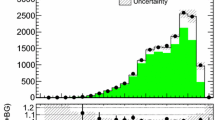Abstract
A new method to measure the top-quark mass in high energetic hadron collisions is presented. We use theoretical predictions calculated at next-to-leading order accuracy in quantum chromodynamics to study the (normalized) differential distribution of the \(t\bar{t} + 1\mbox{-jet}\) cross section with respect to its invariant mass \(\sqrt{s_{t\bar{t} j}}\). The sensitivity of the method to the top-quark mass together with the impact of various theoretical and experimental uncertainties has been investigated and quantified. The new method allows for a complementary measurement of the top-quark mass parameter and has a high potential to become competitive in precision with respect to established approaches. Furthermore we emphasize that in the proposed method the mass parameter is uniquely defined through one-loop renormalization.











Similar content being viewed by others
Notes
Private communication with Pavel Nadolsky.
We observe that in this distribution also the argument of α s plays a role in determining the spectrum: if the second jet is generated by the shower, typically there would be an α s (p T ) factor associated to that emission. Instead, when computed with the exact matrix element, our choice of μ r =m t will results in a larger α s value and thus a harder spectrum, for p T >m t .
\(M^{W}_{T}=\sqrt{2 p_{T}^{\ell} p_{T}^{\nu}(1-\cos(\phi^{\ell}- \phi^{\nu}))}\) where ℓ is the lepton and ν is the neutrino coming from the W→ℓν.
Due to the unavailability of the \(t\bar{t} + 1\mbox{-jet}\) implementation in MC@NLO, this comparison was limited to a \(t \bar{t} \) NLO event sample.
References
T. Aaltonen et al., Phys. Rev. D (2012)
V.M. Abazov et al., Phys. Lett. B 703, 422 (2011). doi:10.1016/j.physletb.2011.08.015
J. Beringer et al., Phys. Rev. D 86, 010001 (2012). doi:10.1103/PhysRevD.86.010001
G. Aad et al., Phys. Lett. B 716, 1 (2012). doi:10.1016/j.physletb.2012.08.020
S. Chatrchyan et al., Phys. Lett. B 716, 30 (2012). doi:10.1016/j.physletb.2012.08.021
S. Heinemeyer, W. Hollik, D. Stockinger, A. Weber, G. Weiglein, J. High Energy Phys. 0608, 052 (2006). doi:10.1088/1126-6708/2006/08/052
G. Degrassi, S. Di Vita, J. Elias-Miro, J.R. Espinosa, G.F. Giudice et al., J. High Energy Phys. 1208, 098 (2012). doi:10.1007/JHEP08(2012)098
S. Alekhin, A. Djouadi, S. Moch, Phys. Lett. B 716, 214 (2012). doi:10.1016/j.physletb.2012.08.024
M.S. Bilenky, S. Caberera, J. Fuster, S. Marti, G. Rodrigo et al., Phys. Rev. D 60, 114006 (1999). doi:10.1103/PhysRevD.60.114006
U. Langenfeld, S. Moch, P. Uwer, Phys. Rev. D 80, 054009 (2009). doi:10.1103/PhysRevD.80.054009
M. Aliev, H. Lacker, U. Langenfeld, S. Moch, P. Uwer et al., Comput. Phys. Commun. 182, 1034 (2011). doi:10.1016/j.cpc.2010.12.040
S. Dittmaier, P. Uwer, S. Weinzierl, Phys. Rev. Lett. 98, 262002 (2007). doi:10.1103/PhysRevLett.98.262002
S. Dittmaier, P. Uwer, S. Weinzierl, Eur. Phys. J. C 59, 625 (2009). doi:10.1140/epjc/s10052-008-0816-y
S. Alioli, S.O. Moch, P. Uwer, J. High Energy Phys. 1201, 137 (2012). doi:10.1007/JHEP01(2012)137
S.D. Ellis, D.E. Soper, Phys. Rev. D 48, 3160 (1993). doi:10.1103/PhysRevD.48.3160
M. Cacciari, G.P. Salam, G. Soyez, J. High Energy Phys. 0804, 063 (2008). doi:10.1088/1126-6708/2008/04/063
M. Cacciari, G.P. Salam, G. Soyez, Eur. Phys. J. C 72, 1896 (2012). doi:10.1140/epjc/s10052-012-1896-2
P.M. Nadolsky et al., Phys. Rev. D 78, 013004 (2008). doi:10.1103/PhysRevD.78.013004
H.L. Lai, J. Huston, S. Mrenna, P. Nadolsky, D. Stump et al., J. High Energy Phys. 1004, 035 (2010). doi:10.1007/JHEP04(2010)035
A. Martin, W. Stirling, R. Thorne, G. Watt, Eur. Phys. J. C 63, 189 (2009). doi:10.1140/epjc/s10052-009-1072-5
S. Alekhin, J. Blumlein, S. Moch, Phys. Rev. D 86, 054009 (2012). doi:10.1103/PhysRevD.86.054009
S. Alioli, P. Nason, C. Oleari, E. Re, J. High Energy Phys. 1006, 043 (2010). doi:10.1007/JHEP06(2010)043
S. Frixione, P. Nason, G. Ridolfi, J. High Energy Phys. 0709, 126 (2007). doi:10.1088/1126-6708/2007/09/126
A. Kardos, C. Papadopoulos, Z. Trocsanyi, Phys. Lett. B 705, 76 (2011). doi:10.1016/j.physletb.2011.09.080
T. Sjöstrand, S. Mrenna, P.Z. Skands, Comput. Phys. Commun. 178, 852 (2008). doi:10.1016/j.cpc.2008.01.036
R. Frederix, F. Maltoni, J. High Energy Phys. 0901, 047 (2009). doi:10.1088/1126-6708/2009/01/047
S. Frixione, B.R. Webber, J. High Energy Phys. 0206, 029 (2002)
G. Corcella, I. Knowles, G. Marchesini, S. Moretti, K. Odagiri et al., J. High Energy Phys. 0101, 010 (2001)
G. Corcella, I. Knowles, G. Marchesini, S. Moretti, K. Odagiri et al. (2002). HERWIG 6.5 release note. arXiv:hep-ph/0210213
P.Z. Skands, D. Wicke, Eur. Phys. J. C 52, 133 (2007). doi:10.1140/epjc/s10052-007-0352-1
T. Sjostrand, S. Mrenna, P.Z. Skands, J. High Energy Phys. 0605, 026 (2006). doi:10.1088/1126-6708/2006/05/026
Acknowledgements
We acknowledge discussions with R. Nisius and S. Martí. We also thank T. Sjostrand for his comments and suggestions to study the color reconnection effects and M. Mangano for his comments on the manuscript. This work is partially supported by the Helmholtz Alliance “Physics at the Terascale” HA-101, by the German Federal Ministry for Education and Research (05H12KHE), by the Spanish Ministry of Economy and Competitivity (FPA2012-39055-C02-01 and AIC-D-2011-0688), by the German Research Foundation (DFG) through SFB-TR9 (B1), and by the European Commission through contract PITN-GA-2010-264564 (LHCPhenoNet).
Author information
Authors and Affiliations
Corresponding author
Rights and permissions
About this article
Cite this article
Alioli, S., Fernandez, P., Fuster, J. et al. A new observable to measure the top-quark mass at hadron colliders. Eur. Phys. J. C 73, 2438 (2013). https://doi.org/10.1140/epjc/s10052-013-2438-2
Received:
Published:
DOI: https://doi.org/10.1140/epjc/s10052-013-2438-2




